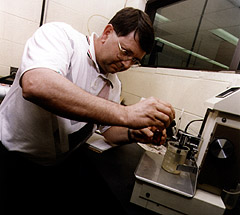 |
Every day, vast quantities of sewage flow from the residential areas
of Prince Albert to a cluster of buildings, which make up Prince
Albert's Pollution Control Centre. Motors push the sewage through
a series of pipes that lead into two huge primary settling tanks,
each about the length and width of a semitrailer. Solids -- called
"primary sludge" -- fall to the bottom of the tank and then go through
a series of steps which removes all remaining liquids. The sludge
is stored in tanks and later burned in incinerators. Meanwhile,
liquid wastes spill out over the outside edge of the settling tanks
into a basin. The waste is then pumped into another complex, treated
with chlorine and dumped back into the North Saskatchewan River.
This primary
system was all that existed when Alain first started managing
the operation in 1995. At that time, he was responsible for overseeing
all plant operations and four employees worked for him. In his
third year, however, the City of Prince Albert decided to improve
their sewage treatment by adding secondary processing. Alain had
to learn everything he could about secondary processing to integrate
the new plant. Then, once he got the new system fully operational
early in 1999, he had to hire and train five additional employees.
He now oversees a facility twice the size of the original plant.
In the new
system, the liquid waste -- or effluent -- flows from the primary
settling tank basin into two giant concrete tanks called bioreactors.
Mushroom-like discs at the bottom of the bioreactors pump extra
oxygen into the tanks -- which in turn feeds natural microorganisms
that break down the sewage. Another set of settling tanks and
a chlorine top-up further purify it before it goes back into the
river. Sludge is no longer incinerated, either. Within a brand
new sludge management building, the solid sludge is collected,
mixed together, and drained again before being trucked offsite
for composting.
"There's always
something challenging about my job," says Alain. "Everyday there's
something new going on, new decisions to be made, and new ideas
to think about."
|
 |


